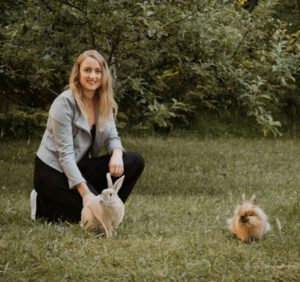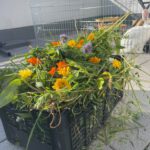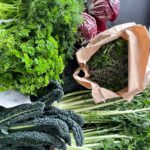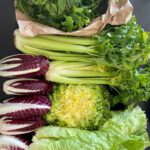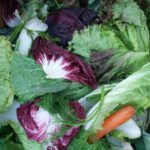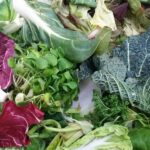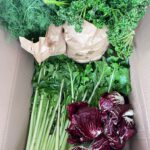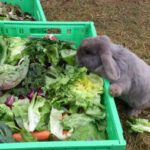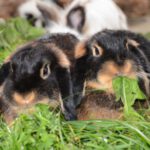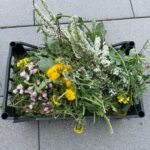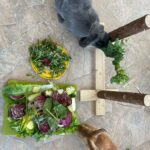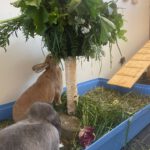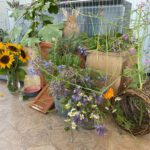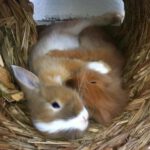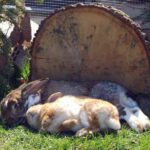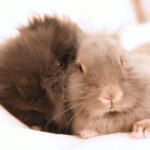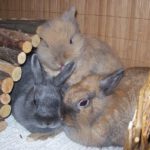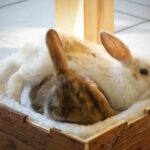How rabbits select the right food from the available options and why they are able to do so.
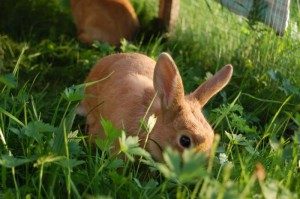
„An animal usually knows best what it needs, as it has acquired this knowledge through adaptation and learning processes. In laboratory conditions, mice [Note: and various other animals] have shown that they are better at understanding how to balance their diet and optimize their health than their human caregivers.
Given the limited knowledge about dietary habits so far, it is hardly surprising that any needs for self-medication are often completely ignored. This vital ‚medicine,‘ which plays a significant role in preventing diseases or restoring health, has not yet been recognized as a necessary aspect of animal care.“
— Dr. Cindy Engel (Biologist and Lecturer in Environmental Science at the Open University, England)
Contents
Wild rabbits set the example…
In the wild, rabbits primarily eat herbs and grasses, which align with their natural diet, and their digestive system, body, and abilities are specifically adapted to this. They prefer the energy-rich, fresh leaf tips and shoots, leaving the woody stems behind. In winter or during food shortages, they have less access to these preferred plants and will also consume woody plants.
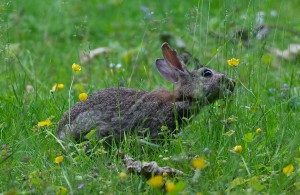
The brown hare, which belongs to the same family and uses the same range of food, is better researched than the wild rabbit. It also feeds on herbs.
Brown hares need around 50 different herbs to maintain their inner balance. These herbs not only provide nourishment but also help them stay healthy. When a hare is ill, it selects specific herbs to heal itself, as each herb contains active ingredients (which are also used in medicines). Through their food choices, they manage to prevent illnesses before they even develop.
German zoologist Michael Boppré goes as far as to claim that the brown hare is in such sharp decline—largely due to the loss of herb selection opportunities (through land consolidation, etc.)—that it is now at risk of extinction.
Learning to Select and Self-Medicate
Rabbits practice food selection.
For brown hares and wild rabbits to develop the ability to find the right plant when they are sick and choose the right food in their everyday life, they follow a fascinating process.
When encountering a plant they do not know, rabbits use their sense of smell, taste, and touch, which allows them to perceive all the signals the plant gives. They rely on all their senses.
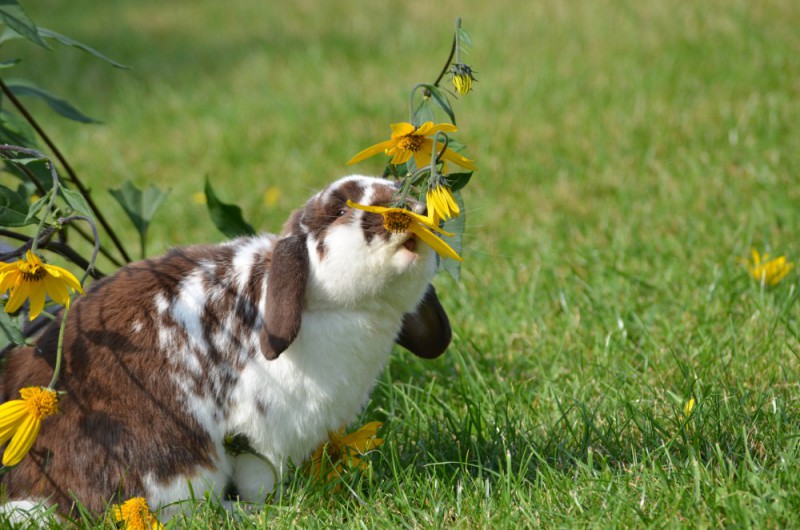
Rabbits always play it safe. The test bite they take (if the plant hasn’t already deterred them with its smell) is so small that even highly toxic plants do not pose a danger. However, the test bite helps the rabbit evaluate the plant’s taste. If it experiences mild health problems afterward (such as stomach pain or discomfort), it will avoid that plant in the future.
Many rabbit owners report that a new plant is only tried once and then left alone. This is the test bite, during which the rabbit tests the plant. Typically, the rabbit will consume larger quantities of the plant the next day.
Rabbits primarily learn through sensory perceptions and experiences. These experiences are passed on, allowing young rabbits to learn from their parents. This happens, in part, through the taste of the mother’s milk (which also contains „the right plants“) and through observing the feeding behavior of adult rabbits.
Selection Behavior in Food Intake
The Test Bite
„Every healthy animal has an instinct for whether a particular plant agrees with it or not. It leaves plants that are unsuitable and chooses the ones that are beneficial.“
— Walter Gadsch, 1942
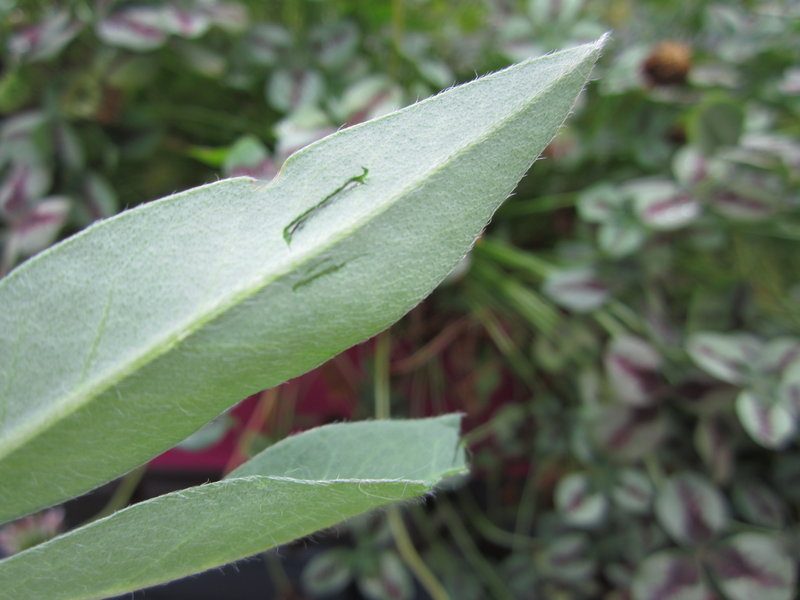
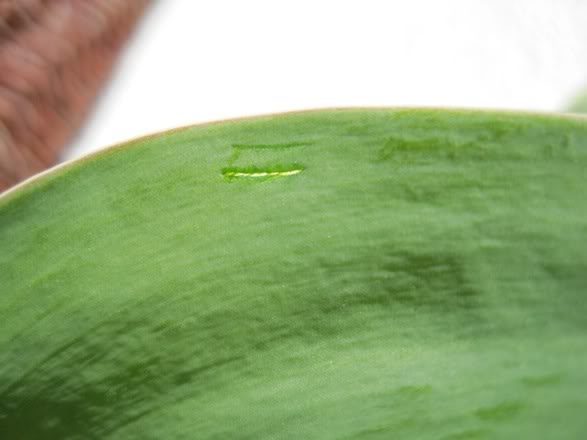
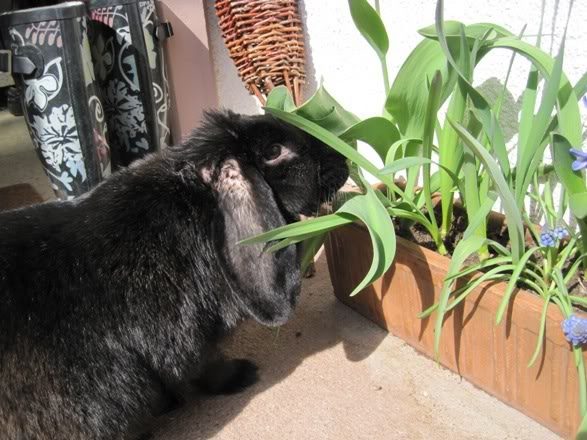
In everyday life, rabbits also eat according to their needs. They specifically prefer plants that their bodies require. Hörnicke therefore opposes the rationing of food, and justifies this as follows:
They cannot, as in nature or with a varied fresh diet, adjust the quality of their nutrient intake according to their metabolic state by preferentially choosing certain food components.
It is best to always provide rabbits with as much food as possible, allowing them to choose from a selection of appropriate, natural plants that meet their nutritional needs and help address minor health issues.
A relatively young field of science, zoopharmacognosy, has come to the surprising conclusion that animals treat themselves through food selection, engaging in self-medication.
As folivores, rabbits use a wide variety of plants with many different active compounds to maintain their health. The richness of ingredients in wild herbs serves as the „pharmacy of nature“ for rabbits, from which they draw for disease prevention. By offering an appropriate selection of plants, you enable your rabbits to specifically choose herbs that strengthen their immune system or help balance minor digestive issues before a full-blown illness can develop.
Since little is known about dietary habits so far, it is hardly surprising that any needs for self-medication are often completely ignored. This extremely important ‚medicine,‘ which contributes so much to preventing diseases or restoring health, has not yet been considered a necessity in animal care.“
— Dr. Cindy Engel (Biologist and Lecturer in Environmental Science at the Open University, England)
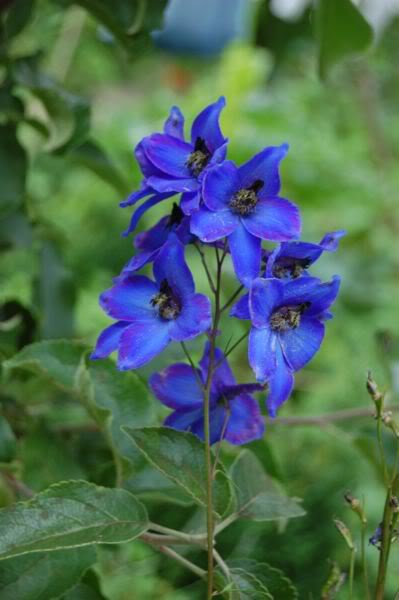
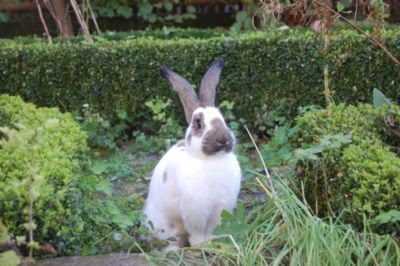
By offering rabbits a wide range of food options, you enable them to specifically choose health-promoting plants and enhance their vitality. Depending on the diseases each individual rabbit may be prone to and what illnesses are promoted by their environment, they will select food accordingly.
In laboratory experiments, scientists have found that animals, when given the right food selection, not only excel at preventing diseases but also know how to compose their meals, effectively creating a perfect daily menu. It has even been acknowledged that, with the right selection available, animals can arrange their meals better than a researcher or caretaker could. Animals can also taste the quality of vegetables and, when given the choice between organically and conventionally grown produce, they typically prefer the organic option. When our pet rabbits have enough variety, they can sort out heavily pesticide-contaminated or otherwise unsuitable food and opt for better alternatives.
Selection Behavior in Toxic Plants
„A wild animal never poisons itself, because it knows which food it must select.“
— Maurice Mességué, 1991
Toxic plants and rabbits are a widely discussed topic. My own rabbits have access to the entire garden during the day, and therefore also have access to many different toxic plants. However, there has not been a single case of poisoning.
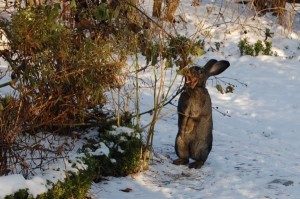
Plant toxicity is a source of concern for rabbit owners, and there are many sources of information that fuel their anxiety. It would be easy if plants could simply be classified as ‚toxic‘ or ’non-toxic.‘ Unfortunately, this is not the case, which is why there are long lists of plants that ‚could‘ be toxic, which are unnecessarily alarming for rabbit owners. In reality, it is very difficult to poison rabbits with plants. History has proven this. Unfortunately, long lists of toxic plants are so distressing for owners that they are encouraged to buy commercial food, which tends to lead to long-term health problems like obesity and dental disease, rather than fresh plants. This risk of toxic plants can prevent owners from picking plants for their pets or allowing their rabbits access to a garden. This is a shame because a diet of fresh plants is enjoyable for rabbits and offers many health benefits. Wild plants are also free, which can be important for owners with many rabbits to feed. Some lists even include vegetables, which is illogical because we eat them ourselves, and our children do too. Chemicals sprayed on vegetables are more of a problem than the vegetables themselves.“
— From veterinarian Frances Harcourt-Brown, a specialist in rabbit care
Why do plants contain toxins?
Most plants produce toxins to deter herbivores from eating them. The reasoning behind this is that by producing toxins, the plant increases its chances of survival and reproduction. Non-toxic plants are eaten, while toxic ones are avoided. This evolutionary advantage ensures that toxic plants thrive and propagate.
Therefore, rabbits can also recognize plant toxins because if plants were consumed despite their toxicity, the purpose of the toxin would be defeated.
However, animals are very adaptable, and many species have learned over time to either use these toxins to their benefit or to circumvent their effects. More on this below.
A Matter of Dose
„All things are poison, and nothing is without poison.“
— Philippus Aureolus Theophrastus Paracelsus, 1493-1541
Every substance becomes deadly beyond a certain amount. For example, water is essential for survival, but consuming 10 liters of it can be fatal for an average adult human.
Therefore, it is not possible to clearly categorize plants as toxic or non-toxic. In principle, all plants are toxic beyond a certain quantity.
Whether something is toxic is not determined by the substance or the plant itself, but solely by the amount consumed.
Poison or Medicine?
The dose is not only crucial in determining whether a plant is beneficial or toxic, but also in achieving a healing effect.
Today’s medications are made from active ingredients, most of which are derived from plants. The pharmaceutical industry takes a plant, extracts the necessary active compounds, and then sells them as medication.
A well-known example is acetylsalicylic acid, which was first extracted from willow bark and is now sold as a headache pill (Aspirin). Medications do not work at all in too small doses, and in larger doses, they are often harmful or even lethal. However, there is a specific dose at which medications have a healing effect.
The same is true for plants—when consumed in the right amount, they can heal diseases.
Also, the hormesis effect, which suggests that small amounts of a substance have the opposite effect of a high dose (i.e., plant toxins in small amounts can stimulate the body and promote better health, a stronger immune system, longer life, and better fertility), should not be forgotten. Especially for rabbits, small amounts of plant toxins are important to keep them healthy.
Dealing with Plant Toxins
„As a veterinarian specializing in the treatment of pet rabbits, I have never seen a case of plant poisoning. I have conducted post-mortem examinations on many rabbits that died unexpectedly, and still, I never diagnosed a plant poisoning. There are many, many other reasons why rabbits can become ill or suddenly die. I have kept rabbits in my garden and conservatory for the last 20 years without illness. When the rabbits were first introduced to the garden, they ate most of my annuals and some of the perennials. Nowadays, the main components of their diet are grass, vegetables, plants, and herbs that they pick from the field, the garden, and the edges. They have access to hay, which they may or may not eat. Outside, my rabbits have free access to fallen apples, rhubarb, ivy, snowdrops, and daffodils without getting sick. […] The snowdrops come up every year, and the rabbits leave them until the leaves have retreated, and then they eat them without getting sick.“ — From veterinarian Frances Harcourt-Brown, a specialist in rabbit care
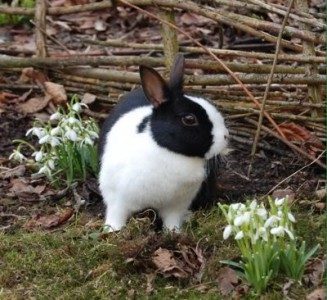
Rabbits have developed excellent strategies over time to avoid plant toxins while still utilizing the plants.
One of these strategies is the combination of different substances. An example is the calcium-to-phosphorus ratio. If too much phosphorus is consumed, it becomes toxic because it interferes with calcium absorption, leading the rabbit to die from calcium deficiency. On the other hand, if too much calcium is consumed, the risk of urinary stones increases, and internal calcifications may occur. Therefore, it is crucial to consume these substances in the correct ratio.
The optimal ratio should be 1.5-2:1 (calcium to phosphorus). So, calcium is essentially a „poison,“ but at the same time, it is vital for survival.
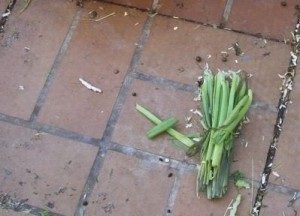
Another method is toxin balancing. Toxins can be neutralized when, for example, geophagy (eating soil) occurs. Earth, clay, and kaolin can neutralize toxins. Dilution methods are also known. Many animals eat other plants after ingesting toxins to dilute them. When rabbits combine the calcium-phosphorus ratio optimally, both substances become non-toxic and can be utilized by the body. This also helps „neutralize“ other plant toxins.
„One should not be too fearful of poisonous plants that frequently occur in meadows. When animals have sufficient food, they naturally avoid highly toxic plants. Small amounts are generally not harmful to rabbits, provided they are otherwise in good nutritional condition and thus have a certain level of resistance.“
— Friedrich Joppich, 1949
Factors That Make Poison Avoidance More Difficult
There are several factors that can significantly hinder poison avoidance.
Many plants change their toxin levels depending on the season or time of day, meaning that rabbits may suddenly be unable to tolerate their usual amount. For example, angel’s trumpets adjust their toxin levels based on sunlight exposure. The amount of hallucinogenic scopolamine fluctuates considerably depending on the intensity of the sun.
Other plants have varying toxicity levels in different parts of the plant. A good example is the tomato plant. While the fruit itself contains no significant amounts of solanine, the green parts of the plant contain much higher levels.
Various limitations can also make poison avoidance more difficult. For instance, if certain plants that help neutralize other toxins are unavailable, the rabbit’s ability to cope with toxic substances is reduced.
„Rabbits are actually quite resistant to poisonous plants. Plants that are harmful to other animals and humans, such as greater celandine, marsh marigold, field bindweed, corn cockle, buttercup, and poppy, are harmless to rabbits and can be fed in moderation when mixed with other plants.“
— Peter Schley, 1985
„There are a number of plants that can cause illness and even death due to poisoning in both humans and animals. Among the most well-known are nightshade, deadly nightshade, autumn crocus, corn cockle, and hemlock. While the danger of these plants to humans and larger domestic mammals is unquestionable, warnings against feeding them to rabbits are largely exaggerated, and the fears they evoke are, for the most part, unfounded.“
— Mangold & Fangauf, 1949
Highly Toxic Plants
Extremely poisonous plants (rabbits should not come into contact with these as a precaution; their ability to select safe foods should not be tested!):
- Spotted arum (Arum maculatum)
- Black henbane (Hyoscyamus niger)
- Nux vomica (Strychnos nux-vomica)
- Yew (Taxus baccata) – 0.7 g needles/kg body weight or 1.75 g needles/animal orally.
- Monkshood (Aconitum napellus)
- Angel’s trumpet (Brugmansia spp.)
- Red foxglove (Digitalis purpurea)
- Autumn crocus (Colchicum autumnale)
- Toxic nightshades – Black nightshade (Solanum nigrum) & bittersweet nightshade (Solanum dulcamara); some, but not all, rabbits are resistant.
- Oleander (Nerium oleander) – 0.005% of body weight in dried oleander leaves.
- Larkspur (Delphinium elatum)
- Hemlock – Spotted hemlock (Conium maculatum) & water hemlock (Cicuta virosa).
- Castor bean plant (Ricinus communis) – 1 g castor beans/kg body weight orally.
The Limits of Selection
Once food is highly processed (ground and baked), contains artificial additives (such as artificial flavors and flavor enhancers that manipulate the sense of taste), or is entirely unnatural (not resembling any food they would find in nature), the ability to make a proper selection reaches its limits.
The same issue arises when animals are starving, kept under unsuitable conditions, or fed incorrectly (leading to eating out of extreme hunger or boredom). Additionally, rabbits must first be introduced to a natural diet, provided with suitable food choices, and accustomed to such a way of eating.


